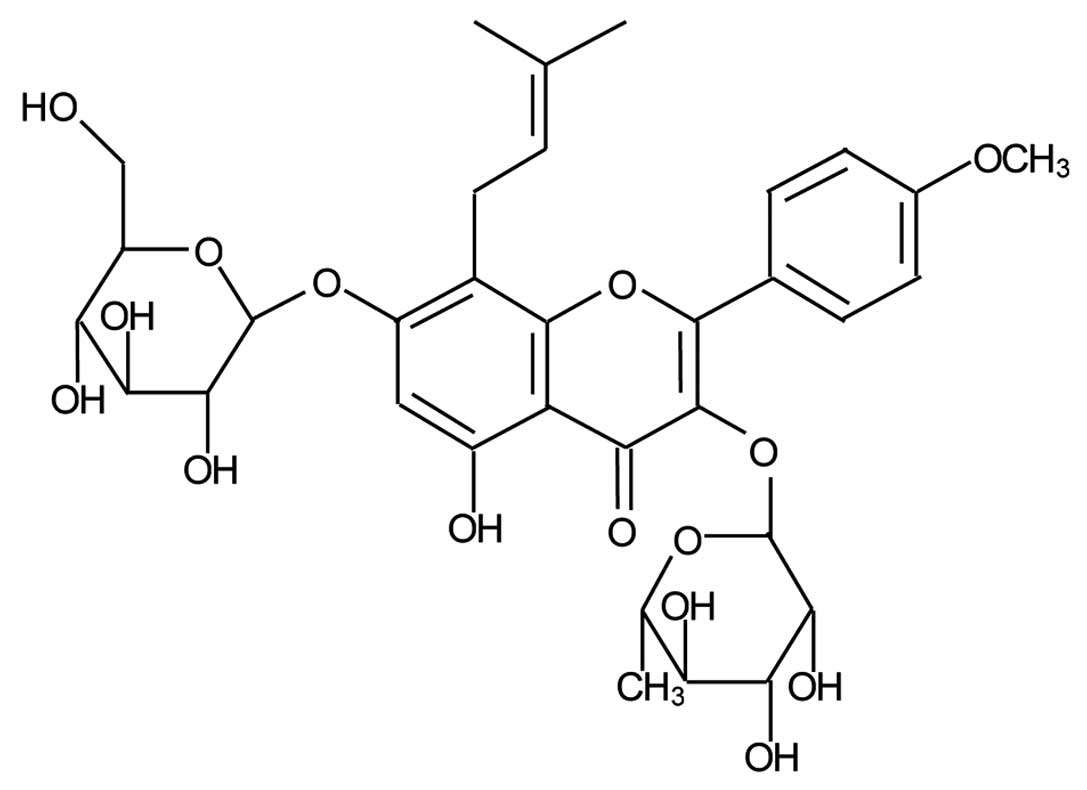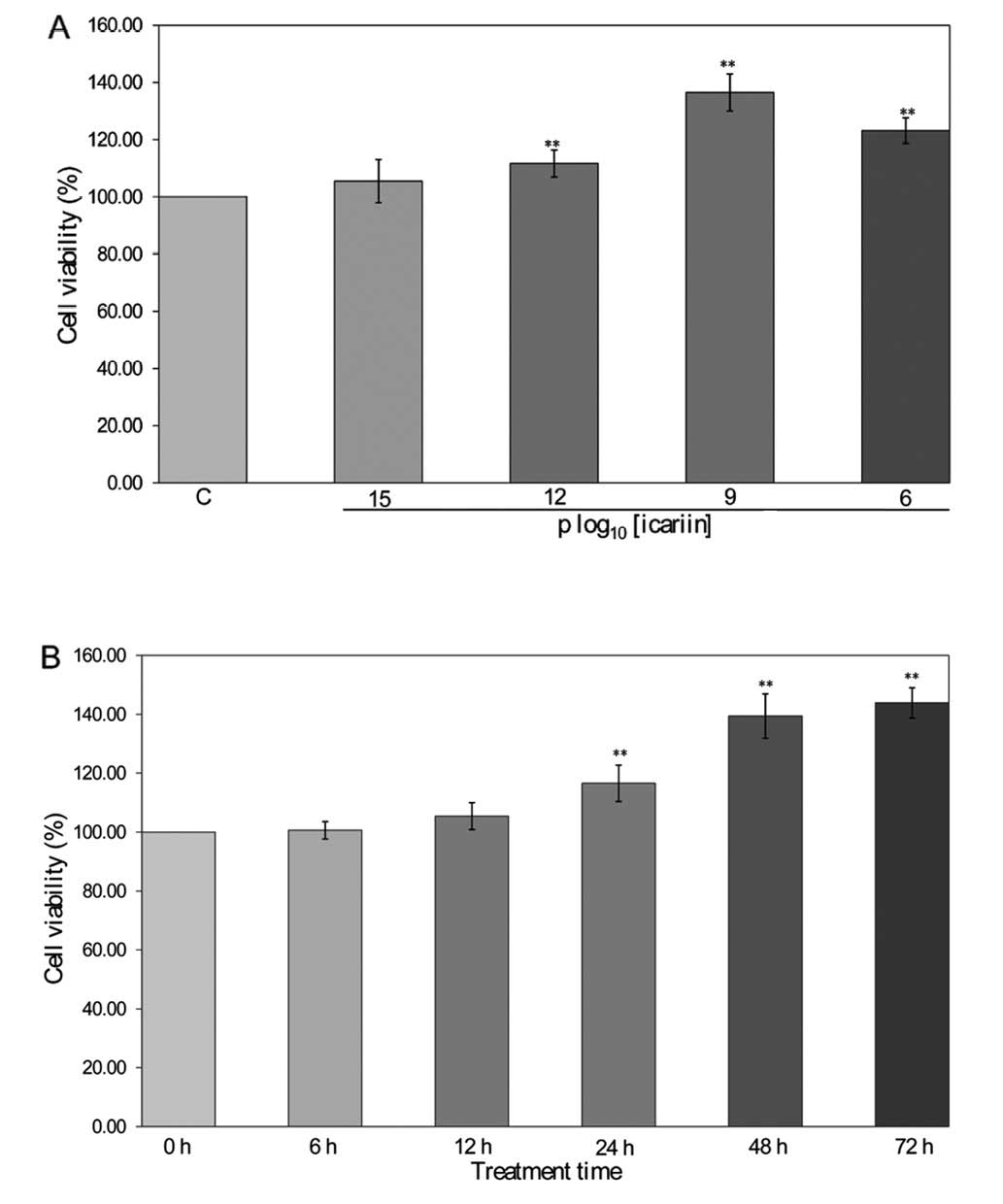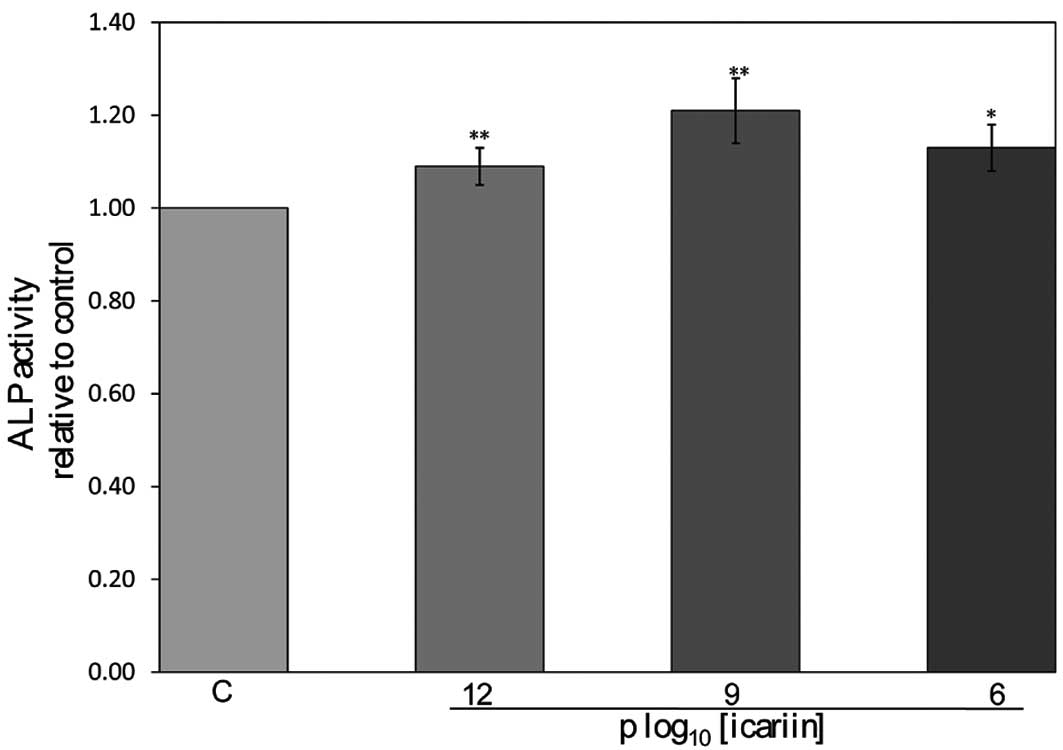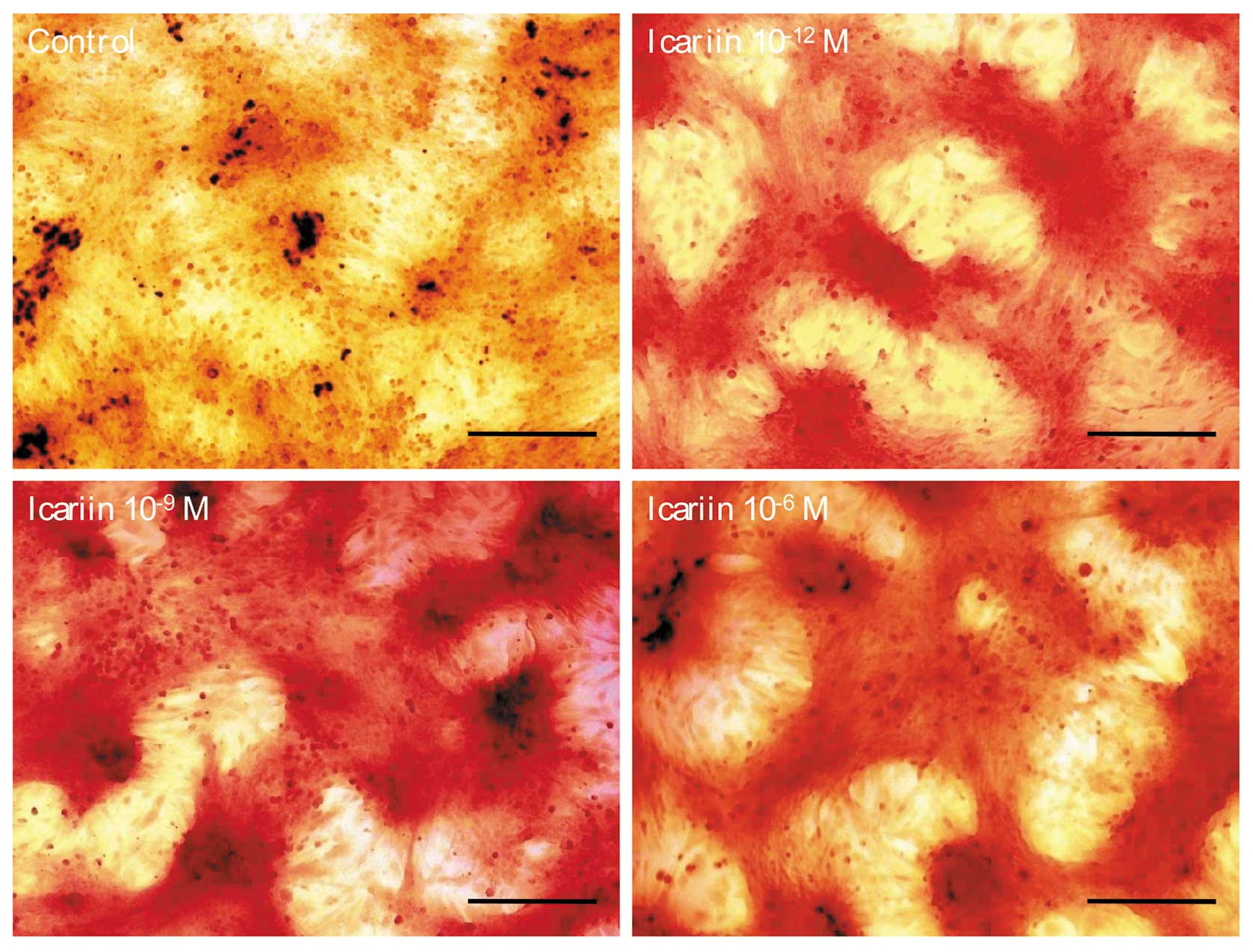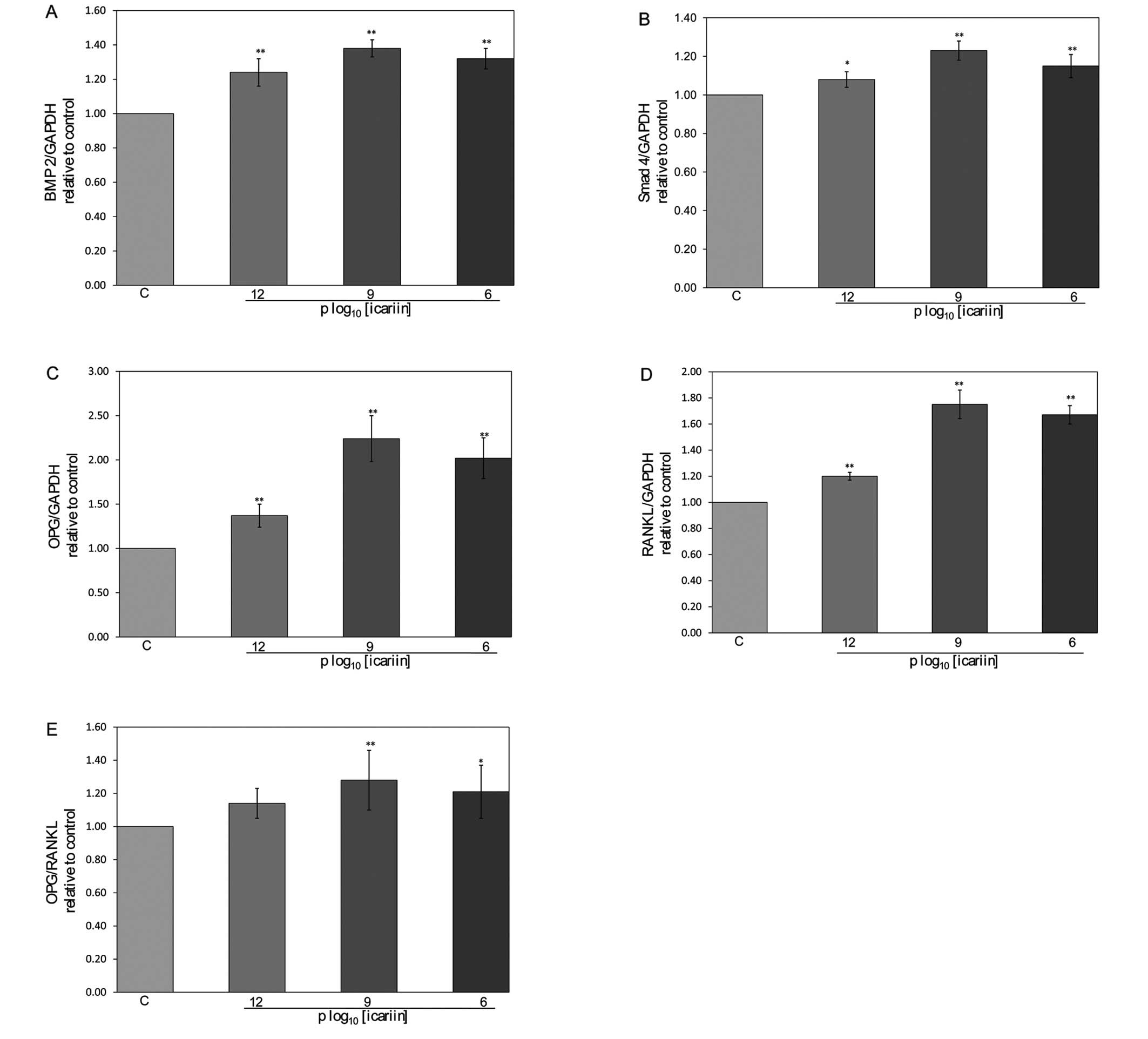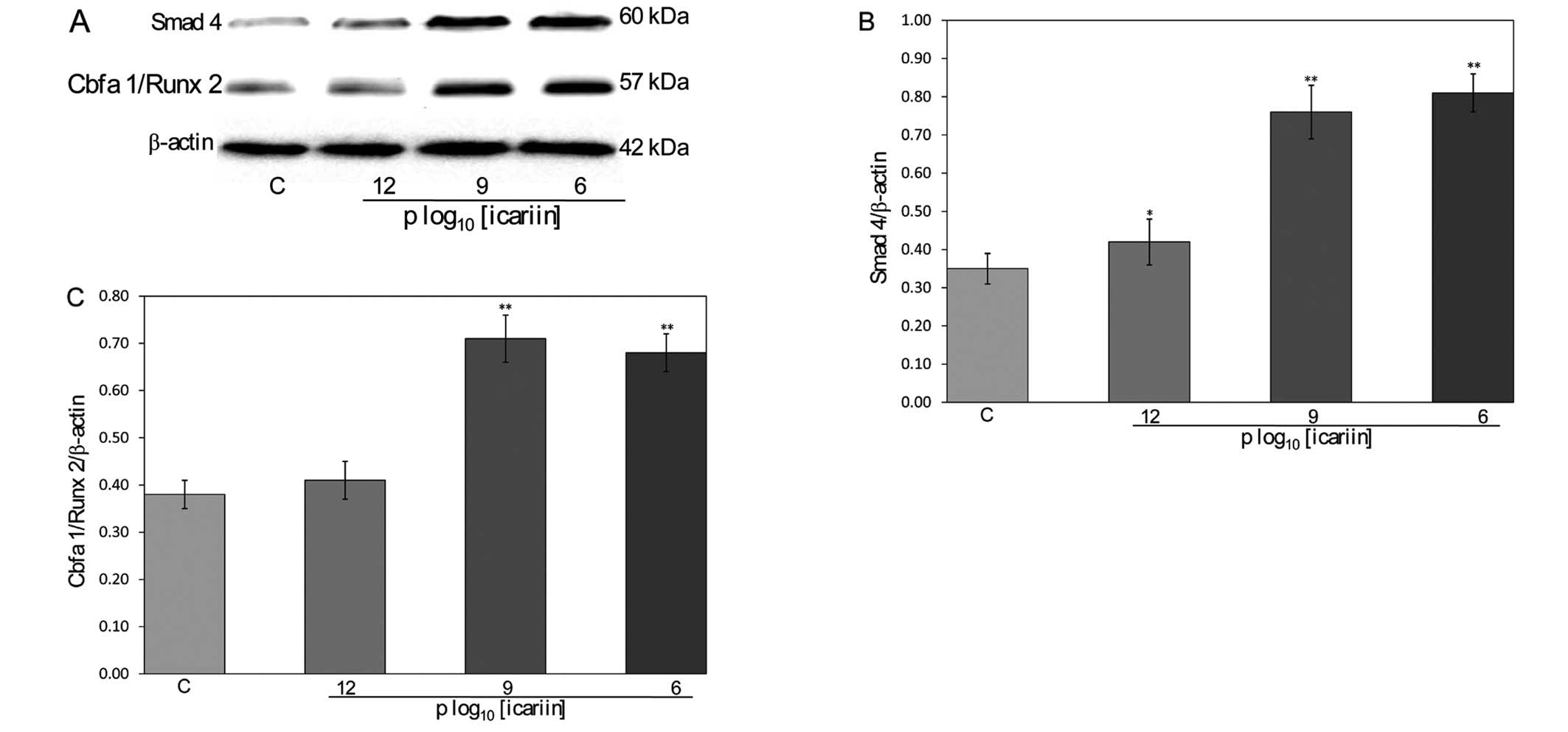Icariin promotes bone formation via the BMP-2/Smad4 signal transduction pathway in the hFOB 1.19 human osteoblastic cell line
- Authors:
- Published online on: July 26, 2012 https://doi.org/10.3892/ijmm.2012.1079
- Pages: 889-895
Abstract
Introduction
Osteoporosis is a common disease characterized by a reduction of bone mass resulting from the negative balance between bone formation and bone destruction (1). It can occur at any age and in any ethnic or racial group, although it is more common in post-menopausal women, and affects millions of people worldwide (2,3). The most serious consequence of osteoporosis is fracture, which is associated with an increase in substantial morbidity, mortality and social costs. Early intervention, now possible with the help of some effective medications, may reduce the risk of first and recurrent fractures (4). However, the lack of reliable and effective drugs to cure osteoporosis-related fragility fractures remains an important global issue. Therefore, there is a clear clinical need to develop new bone anabolic agents for the prevention and treatment of osteoporosis. Natural products that have relatively fewer side-effects have been used clinically. Epimedium, one of the most frequently prescribed herbs, has been utilized in traditional Chinese medicine for the treatment of osteoporosis. Icariin (C33H40O15; molecular weight, 676.67), a flavonol glycoside obtained from this herb, is believed to be the major active compound that accounts for its bone protective actions (Fig. 1) (5,6).
Recently, icariin was found to be therapeutically effective in ovariectomized rats. It increases trabecular bone mineral density (BMD) and bone strength and prevents the suppression of serum Ca levels (7,8). In addition, icariin has been shown to increase cell proliferation, differentiation, mineralization, osteocalcin secretion, as well as the expression levels of bone-related proteins in a dose-dependent manner in primary osteoblastic cells (9–11). These results suggest that icariin prevents bone loss by suppressing bone resorption and stimulating bone formation. However, the understanding of its precise mechanism of biological action in bone formation remains incomplete.
Bone is an active tissue that undergoes constant remodeling in which old bone is degraded by osteoclasts (bone-resorbing cells), and subsequently replaced by new bone formed by osteoblasts (bone-forming cells), via a process known as remodeling (12). Bone remodeling, an active and dynamic process, facilitates the repair of microdamage and provides calcium from bone stores for cellular functions. Osteoblasts are the obvious target for agents that aim to mediate bone anabolism (13,14). A key signaling component in bone formation is bone morphogenic protein-2 (BMP-2), a member of the transforming growth factor-β (TGF-β) superfamily (15,16). BMP-2 signals via Smad4, which is a nuclear transcription factor that regulates the activity of TGF-β ligands and plays an important role in bone formation (17). In the present study, we hypothesized that icariin can modulate the process of bone formation by the BMP-2/Smad4 signal transduction pathway. We assessed the direct effect of icariin on cell viability, alkaline phosphatase (ALP) levels and the amount of calcified nodules, as well as the expression of BMP-2, Smad4, Cbfa1/Runx2, osteoprotegerin (OPG), receptor activator of nuclear factor κ-B ligand (RANKL) and the OPG/RANKL ratio in hFOB 1.19 cells in vitro, and investigated the possible molecular mechanism mediating its biological effect. We found that icariin enhanced the cell viability in a dose- and time-dependent manner. In addition, icariin treatment promoted the amount of calcified nodules in the hFOB 1.19 cells, which was accompanied by the upregulation of the expression of ALP, BMP-2, Smad4, Cbfa1/Runx2, OPG, RANKL and the OPG/RANKL ratio. Our findings suggest that icariin promotes the process of bone formation.
Materials and methods
Materials and reagents
Fetal bovine serum (FBS), Dulbecco’s modified Eagle’s medium (DMEM), and trypsin-EDTA were purchased from Hyclone Laboratories, Inc. (Logan, UT, USA). 3-(4,5-Dimethylthiazol-2-yl)-2,5-diphenyltetrazolium bromide (MTT) was obtained from the Sigma Chemical Co. (St. Louis, MO, USA). TRIzol reagent was purchased from Inc. (Grand Island, NY, USA). Monoclonal rabbit anti-human Smad4, Cbfa1/Runx2, and β-actin HRP secondary goat anti-rabbit antibodies were purchased from Abcam (Cambridge, MA, USA). Primers were synthesized by Sangon Biotech (Shanghai, China). Icariin (HPLC ≥98%) was produced by Nanjing Zelang Medical Technological Co., Ltd. (Nanjing, China). Stock solutions of icariin were prepared by dissolving the icariin powder in DMSO to a concentration of 10−3 M, and stored at −20°C. The working concentrations of icariin were obtained by diluting the stock solution with the culture medium. The final concentration of DMSO in the medium was <0.5%.
Cell culture
The hFOB 1.19 human osteoblastic cell line obtained from the Insitute of Biochemistry and Cell Biology, Chinese Academy of Sciences (Shanghai, China) was cultured in DMEM, supplemented with 10% (v/v) FBS, penicillin (100 U/ml) and streptomycin (100 μg/ml) at 37°C in a humidified incubator with 5% CO2. The medium was replaced every 3 days. At 80–90% confluence, the cells were seeded in 96- or 6-well plates at a density of 1x105 or 3x103 cells/well, respectively, for different assays. The cells used in this study were subjected to ≥30 cell passages.
Evaluation of cell viability by MTT assay
The hFOB 1.19 cell viability was assessed by MTT colorimetric assay. The cells were seeded in 96-well plates at a density of 1.0x105 cells/well, cultured for 24 h and starved for 24 h in serum-free DMEM medium. The cells were treated with icariin at various final concentrations (10−15, 10−12, 10−9 and 10−6 M) and the vehicle control cells were treated with 0.5% DMSO for 48 h. In some experiments, the cells were treated with 10−9 M of icariin for different periods of time. The medium was discarded and replaced with 10 μl MTT [5 mg/ml in phosphate-buffered saline (PBS)]. After incubation at 37°C for 4 h, the purple-blue MTT formazan precipitate was dissolved in 100 μl DMSO and the cells were agitated for 10 min. The absorbance at 490 nm was measured on an ELISA reader (Model EXL800; BioTek, Winooski, VT, USA).
Alizarin red S staining for mineralization
Calcified nodules of the hFOB 1.19 cells were demonstrated by Alizarin red S staining. The cells were seeded in 48-well plates at a density of 2x105 cells/well and cultured for 24 h, and then treated with or without icariin. The medium was replaced every 3 days. After 14 days, the cell cultures were washed 3 times with PBS, fixed with formalin:methanol: H2O (1:1:1.5) 0.5 ml/well for 30 min at room temperature, and then washed 3 times with double distilled water. The cells were stained with 0.1% Alizarin red S at 37°C for 30 min, and washed 5 times with double distilled water and air-dried. The stained calcified nodules that appeared bright red in color were identified by light microscopy.
ALP activity assay
The cells were seeded in 48-well plates at a density of 2x105 cells/well and cultured for 24 h, and then treated with or without icariin for 48 h. Cells were harvested after treatment and lysed with 100 μl Nonidet P-40 lysis buffer (20 mM Tris-HCl, pH 7.5, 150 mM NaCl, 1 mM MgCl2, 1 mM CaCl2, 10% glycerol, 1% Nonidet P-40) supplemented with protease inhibitors [2 μg/ml leupeptin, 2 μg/ml aprotinin and 1 mM phenylmethylsulfonyl fluoride (PMSF)] by incubation on ice for 30 min. The supernatant, centrifuged at 12,000 x g and 4°C for 5 min, was stored at −80°C until analysis. Intracellular ALP activity was determined according to the manufacturer’s instructions. Briefly, the sample was mixed with 1 ml ALP reagent (Hitachi, Tokyo, Japan) and the absorbance change at 405 nm in 3 min was recorded. ALP activity was calculated as: ALP (U/l) = (total volume/sample volume) x (absorbance change in 3 min/0.01875). To normalize the result, bicinchoninic acid (BCA) protein assay was carried out and ALP activity was expressed as units of activity (U)·l−1·(mg protein)−1.
RNA extraction and real-time PCR analysis
After icariin treatment for 48 h, total RNA from the cells was isolated with TRIzol reagent (Invitrogen). Oligo(dT)-primed RNA (5 μg) was reverse-transcribed with SuperScript II reverse transcriptase (Promega) according to the manufacturer’s instructions. The sequences of the PCR primers for the amplification of BMP-2, Smad4, OPG, RANKL and β-actin transcripts were as follows: BMP-2 forward, 5′-CGG ACT GCG GTC TCC TAA-3′ and reverse, 5′-GGA AGC AGC AAC GCT AGA AG-3′, 68 bp; Smad4 forward, 5′-AAA GGT GAA GGT GAT GTT TGG GTC-3′ and reverse, 5′-CTG GAG CTA TTC CAC CTA CTG ATC C-3′, 268 bp; OPG forward, 5′-AGT ACG TCA AGC AGG AGT GCA AT-3′ and reverse, 5′-CCA GCT TGC ACC ACT CCA A-3′, 129 bp; RANKL forward, 5′-AGA GCG CAG ATG GAT CCT AA-3′ and reverse, 5′-TTC CTT TTG CAC AGC TCC TT-3′, 180 bp; and GAPDH forward, 5′-CAA CTA CAT GGT TTA CAT GTT C-3′ and reverse, 5′-GCC AGT GGA CTC CAC GAC-3′, 163 bp. PCR was carried out in a 20 μl reaction mixture containing 10 μl iQTM SYBR-Green Supermix (Bio-Rad Laboratories, Hercules, CA, USA) and 0.5 μl of cDNA template. PCR was performed in an ABI 7900 HT fast real-time PCR system (Applied Biosystems) using the following cycle parameters: 1 cycle of 95°C for 1 min, and 40 cycles of 95°C for 20 sec, different temperatures for 20 sec and 72°C for 18 sec. Upon completion, a melting curve was examined. Standard curves were generated using serially diluted solutions of cDNA derived from the control group sample. The target gene transcripts in each group sample were normalized on the basis of GAPDH.
Western blot analysis
The treated cells were harvested and lysed with Nonidet P-40 lysis buffer (20 mM Tris-HCl, pH 7.5, 150 mM NaCl, 1 mM MgCl2, 1 mM CaCl2, 10% glycerol, 1% Nonidet P-40) supplemented with protease inhibitors (2 μg/ml aprotinin, 2 μg/ml leupeptin and 1 mM PMSF) and phosphatase inhibitors (1 mM sodium orthovanadate, 10 mM NaF). Protein concentrations were determined using the BCA protein assay. Equal amounts of proteins were separated by SDS-PAGE on a 12% reducing gel at a constant voltage (110 V) for approximately 2 h, and transblotted onto PVDF membranes. The non-specific binding sites on the membranes were blocked with 5% skimmed milk. The blots were probed with monoclonal rabbit anti-human Smad4 (1:2,000), Cbfa1/Runx2 (1:1,000) and β-actin (1:1,000) antibodies overnight at 4°C with rocking, followed by incubation with goat anti-rabbit conjugated with horseradish peroxidase (1:2,000). The antigen-antibody complexes were then detected with enhanced chemiluminescence (ECL) reagent (Santa Cruz Biotechnology, Inc., USA). Bands were then quantified by scanning densitometry (170–8070 Molecular Imager ChemiDoc XRS System; Bio-Rad). Protein concentrations were determined using the Tocan 190 protein assay system and normalized to β-actin in the sample.
Statistical analysis
Data were analyzed using the SPSS package for Windows (version 13.0). Quantitative data were expressed as the means ± standard deviation (SD). Statistical analysis of the data was performed with the Student’s t-test and ANOVA. P-value <0.05 was considered to indicate a statistically significant difference.
Results
Effect of icariin on cell viability in hFOB 1.19 cells
Icariin (10−12, 10−9 and 10−6 M) significantly increased cell viability by approximately 111.67±4.72, 136.50±6.47 and 123.17±4.49% in hFOB 1.19 cells compared to the control cells (100±0.00%, P<0.01) (Fig. 2A). The cell viability with 10−9 M of icariin at 24 h (116.57±6.16%), 48 h (139.42±7.53%) and 72 h (143.91±5.13%) was significantly higher than that at 0 h (100±0.00%, P<0.01) (Fig. 2B). These results indicate that icariin enhances osteoblastic cell viability in a dose- and time-dependent manner.
Effect of icariin on ALP activity and calcified nodules in hFOB 1.19 cells
The ALP activity in the hFOB 1.19 cells was increased by 1.09-, 1.21- and 1.13-fold when the cells were treated with icariin at the final concentrations of 10−12, 10−9 and 10−6 M, respectively, significantly higher than that of the control cells (P<0.05) (Fig. 3). The calcified nodules appeared bright red in color by Alizarin red S staining (Fig. 4). Icariin at 10−12, 10−9 and 10−6 M stimulated the formation of calcified nodules significantly compared to the control cells. These results suggest that icariin promotes ALP expression and the formation of calcified nodules in hFOB 1.19 cells.
Effect of icariin on BMP-2, Smad4, OPG and RANKL mRNA expression in hFOB 1.19 cells
Icariin induced a 1.24-, 1.38- and 1.32-fold increase in BMP-2 mRNA expression (P<0.01) (Fig. 5A) and a 1.08-, 1.23- and 1.15-fold increase in Smad4 mRNA expression (P<0.05) (Fig. 5B). Furthermore, icariin not only significantly increased OPG mRNA expression in hFOB 1.19 cells (P<0.01) (Fig. 5C), but also significantly increased RANKL mRNA expression in hFOB 1.19 cells at all concentrations tested (P<0.01) (Fig. 5D). The overall effects of icariin on the OPG/RANKL mRNA expression ratio in hFOB 1.19 cells are shown in Fig. 5E. The results clearly indicated that icariin significantly increased the OPG/RANKL ratio in hFOB 1.19 cells (P<0.05), suggesting that icariin enhances bone formation via its actions on OPG and RANKL expression.
Effect of icariin on Smad4 and Cbfa1/Runx2 protein expression in hFOB 1.19 cells
To further explore the mechanism by which icariin regulates bone formation, we analyzed the protein expression levels of Smad4 and Cbfa1/Runx2 after icariin treatment using western blot analysis (Fig. 6A). Icariin (10−12, 10−9 and 10−6 M) significantly increased Smad4 expression (0.42±0.06, 0.76±0.07 and 0.81±0.05) in the hFOB 1.19 cells compared to the control cells (0.35±0.04, P<0.05) (Fig. 6B). Icariin (10−12, 10−9 and 10−6 M) significantly increased Cbfa1/Runx2 expression (0.41±0.04, 0.71±0.05 and 0.68±0.04) in the hFOB 1.19 cells compared to the control cells (0.38±0.03, P<0.01) (Fig. 6C). Taken together, these results suggest that icariin modulates the process of bone formation via its effects on Smad4 and Cbfa1/Runx2 expression.
Discussion
In the present study, we systematically evaluated the osteoprotective effects and mechanism of actions of icariin in the hFOB 1.19 human osteoblastic cell line. Our results clearly demonstrate that icariin enhances the cell viability and increases the amount of calcified nodules, as well as increasing the expression ratio of OPG/RANKL in hFOB 1.19 cells. In addition, our results show that icariin upregulates the expression of ALP, BMP-2, Smad4, Cbfa1/Runx2, OPG and RANKL, suggesting that it promotes osteoblastic bone formation by the BMP-2/Smad4 signal transduction pathway.
Osteoporosis, a progressive disorder of aging bone, is a worldwide health problem with a high prevalence. Bone is a dynamic tissue whereby old bone is removed by osteoclasts and new bone is formed continuously by osteoblasts. Bone generation, maintenance and healing are complicated processes in which osteoblasts, osteoclasts, and osteocytes are known to play important roles (18). Multiple factors can cause the loss of bone mass, including increased bone turnover, which results in an imbalance of osteoclasts and osteoblasts at the bone remodeling process (19). Therefore, agents with an anabolic action on the bone may be effective in increasing the activity of osteoblasts and treating osteoporosis.
The study of Chinese herbs is worthwhile as this may lead to the discovery of certain agents which can stimulate the proliferation and differentiation of osteoblasts. Recently, Epimedium has received increased attention since many studies on animals and cell culture systems have indicated that icariin plays an important role in the prevention of osteoporosis (20,21). Hence, in the present study, we explored the effect of icariin on the hFOB 1.19 human osteoblastic cell line.
The results of the present study confirm that icariin stimulates the proliferation of hFOB 1.19 cells in a dose- and time-dependent manner. Osteoblasts are derived from mesenchymal stem cells. The sequential expression of type I collagen, ALP and the deposition of calcium are known as molecular markers. Human osteoblasts cultured for 48 h in the presence of 10−12, 10−9 and 10−6 M of icariin exhibited a significant increase in ALP activity, and the formation of mineralized nodules increased significantly after the cells were cultured for 14 days in the presence of 10−12, 10−9 and 10−6 M icariin. As the appearance of ALP activity is an early phenotypic marker for mature osteoblasts, and mineralized nodule formation is a phenotypic marker for a later stage of osteoblast differentiation, our results suggested that icariin stimulated bone formation. Further study is required to clarify the possible additional effects of icariin on renal Ca transport that contribute to the conservation of bone mass in animal models of osteoporosis.
BMPs play important roles in the regulation of bone induction, repair and maintenance (22). BMP-2 has demonstrated a strong osteo-inductive capacity, and has been shown to induce the osteoblastic differentiation of various types of cells, including pre-osteoblasts, undifferentiated mesenchymal cells and bone marrow stromal cells (23). The function of BMP-2 is mediated by heterotetrameric serine/threonine kinase receptors and the downstream transcription factors, Smad1, 5 and 8 (24). After these transcription factors are phosphorylated on serine residues, they form a complex with Smad4 (a common mediator), and subsequently the complex is translocated into the nucleus to activate the transcription of Cbfa1/Runx2, thereby regulating bone metabolism (25). Our results indicated that the BMP-2, Smad4 and Cbfa1/Runx2 expression increased in the icariin-treated hFOB 1.19 cells.
Osteoblasts are recruited to the resorption area and osteoclasts are activated to resorb old bone in the bone remodeling process. OPG and RANKL are critical in determining osteoclastogenesis and bone homeostasis (26,27). OPG blocks these effects and prevents bone resorption, whereas RANKL represents the osteoblast-derived factor required for osteoclast formation (28,29). The levels of OPG and RANKL play important roles in the regulation of the formation of hFOB 1.19 cells. Our study indicates that OPG and RANKL mRNA expression increases after treatment with icariin. As its stimulatory effects on OPG mRNA expression were stronger than those on RANKL mRNA expression, the effects of icariin at 10−9 and 10−6 M on the OPG/RANKL ratio were also stimulatory. These results suggest that icariin promotes bone formation through its direct actions on modulating the expression of OPG and RANKL.
Icariin, an active ingredient identified in Epimedium, is commonly used for the treatment of osteoporosis in traditional Chinese medicine. The present study clearly demonstrates that icariin modulates the process of bone formation via the regulation of the BMP-2/Smad4 signal transduction pathway in hFOB 1.19 cells. Our study provides the evidence to support the use of icariin as an effective candidate for the management of osteoporosis. Further studies are required to elucidate the mechanisms by which icariin protects against bone loss.
Acknowledgements
This study was supported by the National Natural Science Foundation of China (Grant no. 81102609), the Natural Science Foundation of Fujian Province (Grant no. 2011J05076) and the Youth Foundation of Fujian Provincial Health Bureau (Grant no. 2011-2-31).



